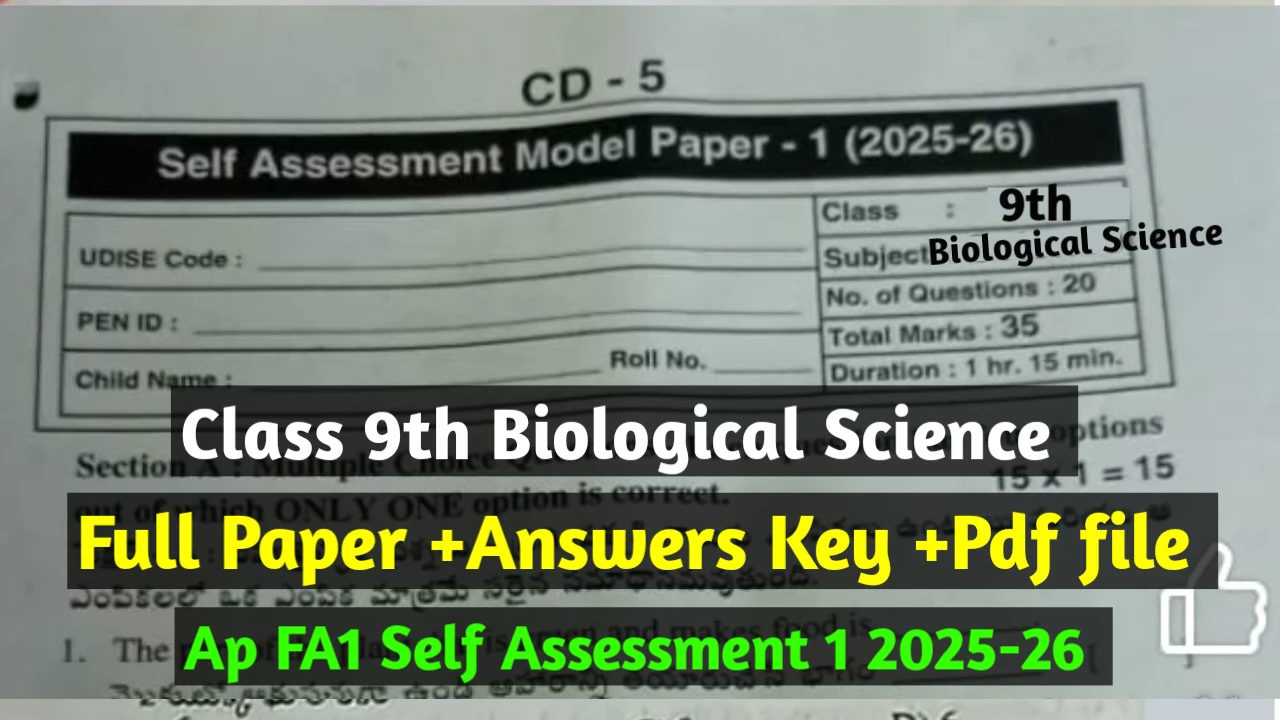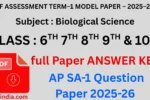AP FA1 9th Biological Science Self-Assessment – I 2025-26 Real Exam Question Paper answer
Table of Contents
AP FA-1 – 2025-26
Class: IX – Biological Science / జీవవిజ్ఞాన శాస్త్రం
Self-Assessment – I / స్వీయ-మూల్యాంకనం – I
Time: 1 Hour / సమయం: 1 గంట
Max. Marks: 35 / గరిష్ట మార్కులు: 35
Section – A: Multiple Choice Questions / బహుళ ఎంపిక ప్రశ్నలు
(15 × 1 = 15 Marks)
Choose the correct answer and write the letter in your answer sheet.
సరైన సమాధానాన్ని ఎంచి సమాధాన పత్రంలో వ్రాయండి.
- In plants, food is prepared in the:
మొక్కలలో ఆహారం తయారయ్యే భాగం ఏది?
a) Roots / వేరు
b) Stem / తాడు
c) Leaves ✅ / ఆకులు
d) Flowers / పువ్వులు - Which pigment is essential for photosynthesis?
ప్రకాశ సంయోజనకు అవసరమైన వర్ణకం ఏది?
a) Carotene / క్యారోటీన్
b) Chlorophyll ✅ / క్లోరోఫిల్
c) Xanthophyll / జాంతోఫిల్
d) Hemoglobin / హీమోగ్లోబిన్ - Which type of respiration produces more energy?
ఎక్కువ శక్తి ఉత్పత్తి చేసే శ్వాసక్రియ ఏది?
a) Anaerobic / ఆమ్లజని లేని శ్వాసక్రియ
b) Aerobic ✅ / ఆమ్లజని తో శ్వాసక్రియ
c) Both equal / రెండూ సమానంగా
d) None / ఏది కాదు - The small pores present on leaves are called:
ఆకులపై ఉండే చిన్న రంధ్రాలను ఏమంటారు?
a) Lenticels / లెంటిసెల్స్
b) Stomata ✅ / రంధ్రాలు
c) Trichomes / ట్రైకోమ్స్
d) Cuticle / క్యూటికిల్ - Which organ filters nitrogenous waste from blood in humans?
మనుషులలో రక్తంలోని నైట్రోజన్ వ్యర్థాలను వడకట్టే అవయవం ఏది?
a) Heart / గుండె
b) Lungs / ఊపిరితిత్తులు
c) Kidneys ✅ / మూత్రపిండాలు
d) Liver / కాలేయం - Which part of the human digestive system absorbs most nutrients?
మనుషుల జీర్ణక్రియలో ఎక్కువ పోషకాలు ఎక్కడ శోషించబడతాయి?
a) Stomach / కడుపు
b) Large intestine / పెద్ద పేగు
c) Small intestine ✅ / చిన్న పేగు
d) Rectum / మలద్వారం - Which blood vessels carry blood away from the heart?
గుండె నుండి రక్తాన్ని బయటకు తీసుకెళ్లే రక్తనాళాలు ఏవి?
a) Veins / శిరలు
b) Arteries ✅ / ధమనులు
c) Capillaries / కేశనాళాలు
d) Lymph vessels / లింఫ్ నాళాలు - The process of breakdown of glucose in absence of oxygen is called:
ఆమ్లజని లేకుండా గ్లూకోజ్ విడిపించే ప్రక్రియ ఏది?
a) Aerobic respiration / ఆమ్లజని తో శ్వాసక్రియ
b) Anaerobic respiration ✅ / ఆమ్లజని లేని శ్వాసక్రియ
c) Fermentation / పులియబెట్టడం
d) Oxidation / ఆక్సీకరణ - Which organ in plants transports water?
మొక్కలలో నీటిని తరలించే భాగం ఏది?
a) Xylem ✅ / జైలమ్
b) Phloem / ఫ్లోయం
c) Cambium / కాంబియం
d) Stomata / రంధ్రాలు - What is the end product of photosynthesis?
ప్రకాశ సంయోజన చివరి ఉత్పత్తి ఏది?
a) CO₂ / కార్బన్ డయాక్సైడ్
b) Glucose ✅ / గ్లూకోజ్
c) Oxygen / ఆమ్లజని
d) ATP / ఏటీపీ - Which valve is present between right atrium and right ventricle?
కుడి ఎట్రియం మరియు కుడి వెంట్రికిల్ మధ్య ఏ వాల్వ్ ఉంటుంది?
a) Tricuspid valve ✅ / ట్రైకస్పిడ్ వాల్వ్
b) Bicuspid valve / బైకస్పిడ్ వాల్వ్
c) Pulmonary valve / పుల్మనరీ వాల్వ్
d) Aortic valve / అవార్టిక్ వాల్వ్ - Which blood component fights against infections?
ఇన్ఫెక్షన్లకు వ్యతిరేకంగా పనిచేసే రక్త భాగం ఏది?
a) RBC / ఎర్ర రక్తకణాలు
b) WBC ✅ / తెల్ల రక్తకణాలు
c) Platelets / రక్తఫలకాలు
d) Plasma / ప్లాస్మా - In humans, the largest gland is:
మనుషులలో అతి పెద్ద గ్రంథి ఏది?
a) Pancreas / అగ్న్యాశయం
b) Liver ✅ / కాలేయం
c) Thyroid / థైరాయిడ్
d) Salivary / లాలాజల గ్రంథి - Which structure prevents backflow of blood in veins?
శిరలలో రక్తం వెనక్కి పోకుండా అడ్డుకునే నిర్మాణం ఏది?
a) Thick walls / మందమైన గోడలు
b) Muscles / కండరాలు
c) Valves ✅ / వాల్వులు
d) Capillaries / కేశనాళాలు - Which gas is released during photosynthesis?
ప్రకాశ సంయోజనలో విడుదలయ్యే వాయువు ఏది?
a) CO₂ / కార్బన్ డయాక్సైడ్
b) Oxygen ✅ / ఆమ్లజని
c) Nitrogen / నైట్రోజన్
d) Methane / మీథేన్
read also- AP FA1 Question Paper (2025–26)
Section – B: Very Short Answer Questions / చాలా చిన్న సమాధాన ప్రశ్నలు
(2 × 2 = 4 Marks)
- What is transpiration? / ఆవిరీభవనం అంటే ఏమిటి?
- English: Loss of water in the form of water vapour from aerial parts of plant.
- Telugu: మొక్క యొక్క పై భాగాల నుండి నీరు ఆవిరి రూపంలో పోవడం.
- Write any two differences between aerobic and anaerobic respiration. / ఏరోబిక్, అనఏరోబిక్ శ్వాసక్రియ మధ్య రెండు తేడాలు వ్రాయండి.
- English:
- Aerobic uses oxygen; anaerobic does not.
- Aerobic produces more energy; anaerobic produces less.
- Telugu:
- ఏరోబిక్లో ఆమ్లజని అవసరం; అనఏరోబిక్లో అవసరం లేదు.
- ఏరోబిక్ ఎక్కువ శక్తి ఉత్పత్తి చేస్తుంది; అనఏరోబిక్ తక్కువ శక్తి ఉత్పత్తి చేస్తుంది.
- English:
read also- Biology FA1 Self-Assessment Question Papers 2025 Classes 7th 8th 9th 10th
Section – C: Short Answer Questions / చిన్న సమాధాన ప్రశ్నలు
(2 × 4 = 8 Marks)
- Explain the process of transportation in plants. / మొక్కలలో పదార్థాల రవాణా ప్రక్రియను వివరించండి.
- English:
- Xylem transports water and minerals from roots to other parts.
- Phloem transports prepared food from leaves to other parts.
- Telugu:
- జైలమ్ వేరు నుండి నీరు, ఖనిజాలను ఇతర భాగాలకు తరలిస్తుంది.
- ఫ్లోయం ఆకుల నుండి తయారైన ఆహారాన్ని ఇతర భాగాలకు తరలిస్తుంది.
- English:
- Describe the human excretory system. / మానవ విసర్జన వ్యవస్థను వివరించండి.
- English:
- Main organs: kidneys, ureters, urinary bladder, urethra.
- Kidneys filter blood to remove urea, uric acid.
- Telugu:
- ప్రధాన అవయవాలు: మూత్రపిండాలు, యురేటర్లు, మూత్రాశయం, మూత్రనాళం.
- మూత్రపిండాలు రక్తాన్ని వడకట్టి యూరియా, యూరిక్ యాసిడ్ తొలగిస్తాయి.
- English:
Section – D: Essay Question / వ్యాస ప్రశ్న
(1 × 8 = 8 Marks)
Describe the process of photosynthesis with equation. / సమీకరణంతో సహా ప్రకాశ సంయోజన ప్రక్రియను వివరించండి.
- English:
- Plants use sunlight, CO₂, water, and chlorophyll to make glucose.
- Two phases: light reaction & dark reaction.
- Equation: 6CO₂ + 6H₂O → C₆H₁₂O₆ + 6O₂
- Telugu:
- మొక్కలు సూర్యకాంతి, CO₂, నీరు, క్లోరోఫిల్ సహాయంతో గ్లూకోజ్ తయారు చేస్తాయి.
- రెండు దశలు: కాంతి దశ, చీకటి దశ.
- సమీకరణం: 6CO₂ + 6H₂O → C₆H₁₂O₆ + 6O₂


